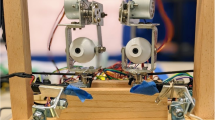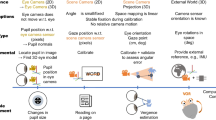Abstract
Purpose
We present a new method to evaluate the accuracy of an eye tracker-based eye localization system. Measuring the accuracy of an eye tracker’s primary intention, the estimated point of gaze, is usually done with volunteers and a set of fixation points used as ground truth. However, verifying the accuracy of the location estimate of a volunteer’s eye center in 3D space is not easily possible. This is because the eye center, the center of corneal curvature, is an intangible point.
Methods
We evaluate the eye location accuracy by using an eye phantom instead of eyes of volunteers. For this, we developed a testing stage with a realistic artificial eye and a corresponding kinematic model, which we trained with \(\mu \text {CT}\) data. This enables us to precisely evaluate the eye location estimate of an eye tracker.
Results
We show that the proposed testing stage with the corresponding kinematic model is suitable for such a validation. Further, we evaluate a particular eye tracker-based navigation system and show that this system is able to successfully determine the eye center with a mean accuracy of 0.68 mm.
Conclusion
We show the suitability of the evaluated eye tracker for eye interventions, using the proposed testing stage and the corresponding kinematic model. The results further enable specific enhancements of the navigation system to potentially get even better results.









Similar content being viewed by others
References
Besl PJ, McKay HD (1992) A method for registration of 3-D shapes. IEEE Trans Pattern Anal Mach Intell 14(2):239–256
Duchowski AT (2007) Eye tracking methodology—theory and practice, 2nd edn. Springer, London
Guestrin ED, Eizenman M (2006) General theory of remote gaze estimation using the pupil center and corneal reflections. IEEE Trans Biomed Eng 53(6):1124–1133
Hansen DW, Ji Q (2010) In the eye of the beholder: a survey of models for eyes and gaze. IEEE Trans Pattern Anal Mach Intell 32(3):478–500
Leon SJ (1980) Linear algebra with applications. Macmillan, New York
Lotmar W (1971) Theoretical eye model with aspherics*. J Opt Soc Am 61(11):1522–1529
Narcizo FB, Rangel de Queiroz JE, Gomes HM (2013) Remote eye tracking systems: technologies and applications. In: 2013 26th conference on graphics, patterns and images tutorials. IEEE, pp 15–22
Schindelin J, Arganda-Carreras I, Frise E, Kaynig V, Longair M, Pietzsch T, Preibisch S, Rueden C, Saalfeld S, Schmid B, Tinevez JY, White DJ, Hartenstein V, Eliceiri K, Tomancak P, Cardona A (2012) Fiji: an open-source platform for biological-image analysis. Nat Methods 9(7):676–682
Świrski L, Dodgson N (2014) Rendering synthetic ground truth images for eye tracker evaluation. In: Proceedings of the 2014 symposium on eye-tracking research & applications. ACM, New York, pp 219–222
Via R, Fassi A, Fattori G, Fontana G, Pella A, Tagaste B, Riboldi M, Ciocca M, Orecchia R, Baroni G (2015) Optical eye tracking system for real-time noninvasive tumor localization in external beam radiotherapy. Med Phys 42(5):2194–2202
Wyder S, Cattin PC (2016) Stereo eye tracking with a single camera for ocular tumor therapy. In: Proceedings of the ophthalmic medical image analysis international workshop, pp 81–88
Wyder S, Hennings F, Pezold S, Hrbacek J, Cattin PC (2016) With gaze tracking toward noninvasive eye cancer treatment. IEEE Trans Biomed Eng 63(9):1914–1924
Zhang Z (2000) A flexible new technique for camera calibration. IEEE Trans Pattern Anal Mach Intell 22(11):1330–1334
Acknowledgements
We would like to thank the members of the Biomaterials Science Center (BMC) of the University of Basel for their support with the data acquisition with the \(\mu \text {CT}\) system. We thank also Otto E. Martin from the Swiss Institute For Artificial Eyes for providing us a hand-crafted eye and for sharing his profound knowledge. The work is funded by the Swiss National Science Foundation (SNSF).
Author information
Authors and Affiliations
Corresponding author
Ethics declarations
Conflict of interest
The authors declare that they have no conflict of interest.
Human and animal rights
This article does not contain any studies with human participants or animals performed by any of the authors. This articles does not contain patient data.
Rights and permissions
About this article
Cite this article
Wyder, S., Cattin, P.C. Eye tracker accuracy: quantitative evaluation of the invisible eye center location. Int J CARS 13, 1651–1660 (2018). https://doi.org/10.1007/s11548-018-1808-5
Received:
Accepted:
Published:
Issue Date:
DOI: https://doi.org/10.1007/s11548-018-1808-5




